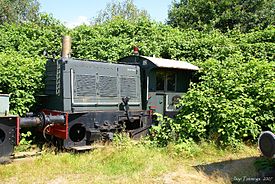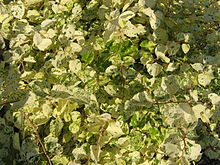- Japanese knotweed
-
Japanese Knotweed 
Scientific classification Kingdom: Plantae (unranked): Angiosperms (unranked): Eudicots (unranked): Core eudicots Order: Caryophyllales Family: Polygonaceae Genus: Fallopia Species: F. japonica Binomial name Fallopia japonica
Houtt. (Ronse Decr.)Japanese Knotweed (Fallopia japonica, syn. Polygonum cuspidatum, Reynoutria japonica) is a large, herbaceous perennial plant, native to eastern Asia in Japan, China and Korea. In North America and Europe the species is very successful and has been classified as an invasive species in several countries.
A member of the family Polygonaceae, Japanese knotweed has hollow stems with distinct raised nodes that give it the appearance of bamboo, though it is not closely related. While stems may reach a maximum height of 3–4 m each growing season, it is typical to see much smaller plants in places where they sprout through cracks in the pavement or are repeatedly cut down. The leaves are broad oval with a truncated base, 7–14 cm long and 5–12 cm broad, with an entire margin. The flowers are small, cream or white, produced in erect racemes 6–15 cm long in late summer and early autumn.
Closely related species include giant knotweed (Fallopia sachalinensis, syn. Polygonum sachalinense) and Russian vine (Fallopia baldschuanica, syn. Polygonum aubertii, Polygonum baldschuanicum).
Other English names for Japanese knotweed include fleeceflower, Himalayan fleece vine, monkeyweed, Huzhang (Chinese: 虎杖; pinyin: Hǔzhàng, literally "tiger stick"), Hancock's curse, elephant ears, pea shooters, donkey rhubarb (although it is not a rhubarb), sally rhubarb, Japanese bamboo, American bamboo, and Mexican bamboo (though it is not a bamboo). There are also regional names, and it is sometimes confused with sorrel.
In Japanese, the name is itadori (虎杖, イタドリ).[1]
Contents
Invasive species
In the U.S. and Europe, Japanese knotweed is widely considered an invasive species or weed.[2] It is listed by the World Conservation Union as one of the world's 100 worst invasive species.[3]
The invasive root system and strong growth can damage foundations, buildings, flood defences, roads, paving, retaining walls and architectural sites. It can also reduce the capacity of channels in flood defenses to carry water.[4]
It is a frequent colonizer of temperate riparian ecosystems, roadsides and waste places. It forms thick, dense colonies that completely crowd out any other herbaceous species and is now considered one of the worst invasive exotics in parts of the eastern United States. The success of the species has been partially attributed to its tolerance of a very wide range of soil types, pH and salinity. Its rhizomes can survive temperatures of −35 °C (−31 °F) and can extend 7 metres (23 ft) horizontally and 3 metres (9.8 ft) deep, making removal by excavation extremely difficult. The plant is also resilient to cutting, vigorously re-sprouting from the roots. The most effective method of control is by herbicide application close to the flowering stage in late summer or autumn. In some cases it is possible to eradicate Japanese knotweed in one growing season using only herbicides. Trials in the Queen Charlotte Islands (Haida Gwaii) of British Columbia using sea water sprayed on the foliage have demonstrated promising results, which may prove to be a viable option for eradication where concerns over herbicide application are too great.[citation needed]
It can be found in 39 of the 50 United States[5] and in six provinces in Canada. It is listed as an invasive weed in Ohio, Vermont, Virginia, West Virginia, New York, Alaska, Pennsylvania, Oregon and Washington state.[6] The species is also common in Europe. In the UK it was made illegal to spread Japanese knotweed by the Wildlife and Countryside Act 1981. It is also classed as "controlled waste" in Britain under part 2 of the Environmental Protection Act 1990. This requires disposal at licensed landfill sites.[7]
Two biological pest control agents that show promise in the control of the plant are the psyllid Aphalara itadori[8] and a leaf spot fungus from genus Mycosphaerella.[9]
Uses
Japanese knotweed flowers are valued by some beekeepers as an important source of nectar for honeybees, at a time of year when little else is flowering. Japanese knotweed yields a monofloral honey, usually called bamboo honey by northeastern U.S. beekeepers, like a mild-flavored version of buckwheat honey (a related plant also in the Polygonaceae).
The young stems are edible as a spring vegetable, with a flavor similar to mild rhubarb. In some locations, semi-cultivating Japanese knotweed for food has been used as a means of controlling knotweed populations that invade sensitive wetland areas and drive out the native vegetation.[10] Some caution should be exercised when consuming this plant because it, similar to rhubarb, contains oxalic acid, which may aggravate conditions such as rheumatism, arthritis, gout, kidney stones or hyperacidity.[11]
Both Japanese knotweed and giant knotweed are important concentrated sources of resveratrol, replacing grape byproducts. Many large supplement sources of resveratrol now use Japanese knotweed and use its scientific name in the supplement labels. The plant is useful because of its year-round growth and robustness in different climates.[12]
Japanese knotweed is a concentrated source of emodin, used as a nutritional supplement to regulate bowel motility.[citation needed] The roots of Japanese knotweed are used in traditional Chinese and Japanese herbal medicines as a natural laxative.[citation needed] The active principle responsible for the laxative effect is emodin, present in its natural form as a complex of its analogs. Emodin has a mild laxative effect in doses of 20 to 50 mg per day.[citation needed]
Methanol extracts of the roots of Polygonum cuspidatum (Polygonaceae), traditionally used in Korea to maintain oral health, were shown to reduce the viability of Streptococcus mutans and Streptococcus sobrinus as well as inhibit sucrose-dependent adherence, water-insoluble glucan formation, glycolytic acid production and acid tolerance. The authors suggested that inhibitory effects may be mediated by the presence of alkaloids, phenolics, sterols, and terpenes in the extract.[13]
 This antique locomotive at Beekbergen, Netherlands is overgrown by knotweed. A few years ago, it was knotweed-free
This antique locomotive at Beekbergen, Netherlands is overgrown by knotweed. A few years ago, it was knotweed-free
Control
Japanese knotweed has a large underground network of roots (rhizomes). To eradicate the plant the roots need to be killed. All above-ground portions of the plant need to be controlled repeatedly for several years in order to weaken and kill the entire patch. Picking the right herbicide is essential, as it must travel through the plant and into the root system below. Glyphosate is the best active ingredient in herbicide for use on Japanese knotweed as it is ’systemic’; it penetrates through the whole plant and travels to the roots.[citation needed]
Digging up the rhizomes is a common solution where the land is to be developed, as this is quicker than the use of herbicides, but disposal of the plant material is difficult, governed by law in the UK, where it is classed as controlled waste.
More ecologically friendly means are being tested as an alternative to chemical treatments. Soil steam sterilization [14] involves injecting steam into contaminated soil in order to kill subterranean plant parts. Research has also been carried out on Mycosphaerella leafspot fungus, which devastates knotweed in its native Japan. Research with Mycosphaerella has been relatively slow, due to its complex life cycle.[15]
In the UK, it is an offence under section 14(2) of the Wildlife and Countryside act 1981 to "plant or otherwise cause to grow in the wild" any plant listed in Schedule nine, Part II to the Act, which includes Japanese knotweed. Over £150m is spent annually on Japanese knotweed control, and a decision was taken on 9 March 2010 in the UK to release into the wild a Japanese psyllid insect, Aphalara itadori.[16] Its diet is highly specific to Japanese knotweed and shows good potential for its control[17][18]
References
- ^ "itadori". Denshi Jisho — Online Japanese dictionary. http://jisho.org/words?jap=itadori&eng=&dict=edict&romaji=on. Retrieved 9 March 2010.
- ^ Biological control of invasive plants in the Eastern United States
- ^ IUCN Global Invasive Species Database
- ^ Article on the costs of Japanese Knotweed
- ^ PUSDA
- ^ USDA weed profile for Japanese knotweed
- ^ Relevant Legislation for handling and disposing of japanese knotweed
- ^ "Tell me, sweet little lice" Naturenet article on psyllid control of knotweed
- ^ Morelle, R. Alien invaders hit the UK. BBC News October 13, 2008.
- ^ Pilot project of Bionic Knotweed Control in Wiesbaden, Germany
- ^ Edible Plants - Japanese Knotweed
- ^ Pest Diagnostic Unit, University of Guelph
- ^ B.Parimala Devi et al. (2009). Journal of Pharmacy Research 2 (11): 1669–1675. http://jpronline.info/article/view/906/708.
- ^ Soil-Steaming-Report, 03. Okt. 2009
- ^ Notes on Biological control and Japanese knotweed
- ^ BBC News
- ^ Richard H. Shaw, Sarah Bryner and Rob Tanner. "The life history and host range of the Japanese knotweed psyllid, Aphalara itadori Shinji: Potentially the first classical biological weed control agent for the European Union". UK Biological Control. Volume 49, Issue 2, May 2009, Pages 105-113.
- ^ CABI Natural control of Japanese knotweed
External links
- Species Profile- Japanese Knotweed (Fallopia japonica), National Invasive Species Information Center, United States National Agricultural Library. Lists general information and resources for Japanese Knotweed.
- Best management practice A variety of ways to control knotweed (under "knotweed")(USA)
- Strategies for the eradication of Japanese knotweed
- American Journal of Botany - Sexual Reproduction in the Invasive Species Fallopia japonica
- Knotweed page on KnottyBits.com
- Japanese Knotweed Alliance (UK)
- Recipes from "Wildman" Steve Brill
- Time lapse video of knotweed growth BBC
- Insect that fights Japanese knotweed to be released BBC News 2010-03-09
Categories:- Polygonaceae
- Flora of Japan
- Flora of Korea
- Flora of China
- Invasive plant species
- Invasive plant species in Europe
- Invasive plant species in the United States
- Invasive plant species in Oregon
- Stem vegetables
- Medicinal plants
- Honey plants
- Garden plants of Asia
Wikimedia Foundation. 2010.





